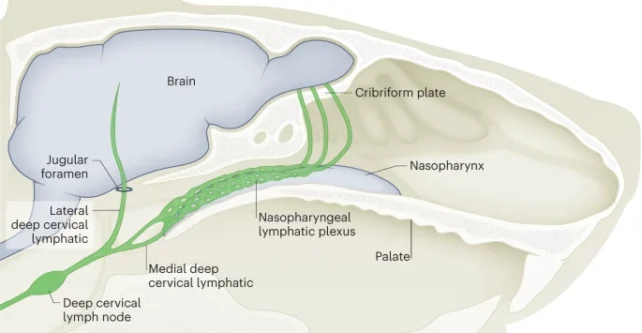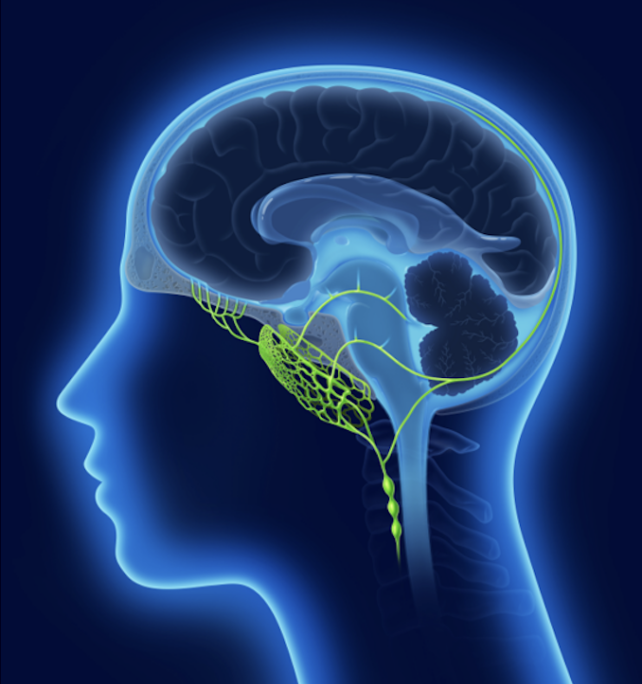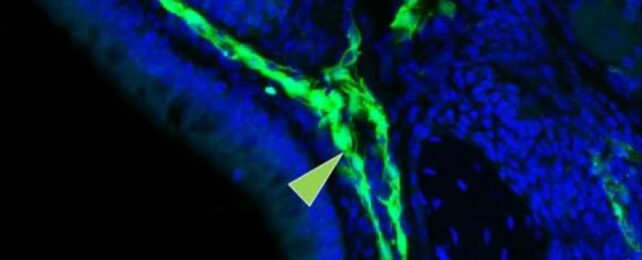Scientists have discovered a 'secret passageway' in mice that connects the brain to the body's lymphatic system.
The network of vessels appears to form an overlooked brain drainage system that plays a crucial role in maintaining the health and function of the central nervous system.
If the findings extend to humans, it could fundamentally change how scientists understand the circulation of fluid that bathes the brain and spinal cord.
Cerebrospinal fluid (CSF) is a colorless liquid that carries nutrients to the central nervous system, maintains fluid balance, and clears away waste products from brain tissue.
In humans, CSF is drained and replaced constantly, turning over three to five times a day. However, that clearance can slow with age, and it is correlated with sleep quality and cognitive function.
Knowing how the CSF circulates is essential to our knowledge of human health and disease, and yet we still don't really know where all that fluid goes when our brains are done with it. For decades, experts believed CSF drained through special veins that surround the brain and spinal cord, and yet recent data suggests that notion is wrong.
CSF might not drain through the vascular system at all, but through the body's lymph nodes.
A new study, led by researchers at South Korea's Institute for Basic Science and the University of Missouri in the United States, has identified a previously unknown thoroughfare that carries CSF from the brain to lymph nodes in the neck.
According to the international team of researchers, a distinctive network of lymphatic vessels lies near the top part of the throat in mice, just behind their nose, that has never been clearly identified before.
By inserting fluorescent markers into rodent brain tissue and the brains of living mice, the researchers mapped a network called the nasopharyngeal lymphatic plexus, showing it is a major hub for the drainage of CSF.
The findings confirm previous brain imaging data, collected in 2022, that found CSF in mice drained through lymphatics located in the nasopharnyx.
In a review for Nature, University of Bern physiologists Irene Spera and Steven Proulx applaud the recent discovery. As authors of studies suggesting the possibility of such a 'secret passage', they say the results provide "indisputable evidence that, at least in mice, the nasopharyngeal lymphatic plexus has a crucial involvement in CNS clearance."
"This plexus, beautifully rendered in three dimensions… is composed of a dense network of lymphatic vessels that wraps around the circumference of the nasopharynx," Spera and Proulx write.

Even more promising, this lymphatic plexus is not just present in mice. Lead researchers Jin-Hui Yoon, Hokyung Jin, and Hae Jin Kim also examined the brains of crab-eating macaques and found a similar structure in the exact same spot.
Although the team didn't get to see the vessels draining in action like they did in mice, the findings among primates suggest this pathway is conserved across diverse mammalian species.
"This discovery could have significant implications for understanding and treating conditions related to impaired CSF drainage," says Jin, who hails from the Institute for Basic Science and the Korea Advanced Institute of Science and Technology (KAIST).
In human neurodegenerative disorders, like Alzheimer's disease, for instance, waste products like tau or amyloid beta often build up in the brain.
CSF circulation could be tied to that outcome.
In mice, researchers found the nasopharyngeal lymphatic plexus shrinks with age and is not able to clear as much CSF. When the team stimulated these run-down vessels with a growth factor protein, they were able to improve their fluid draining function, possibly indicating a target for neurodegenerative treatment.
Among humans, some recent evidence does suggest that CSF can drain into the nasal cavity at the top of the throat via cranial nerves.
That said, not all scientists are convinced. It is still not clear how CSF drains from the nasal cavity to lymph nodes in the neck.
Jin and his colleagues have detailed the most convincing explanation to date, with two sets of lymphatic vessels draining CSF to deep cervical lymph nodes in mice.
Based on the results from rodents and monkeys, the team suspects the human plexus could look like the image below, if it exists at all.

"We plan to verify all the findings from the mice in primates, including monkeys and humans," says supervisor Gou Young Koh from the Institute for Basic Science.
"We aim to investigate in a reliable animal model whether activating the cervical lymphatic vessels through pharmacological or mechanical means can prevent the exacerbation of Alzheimer's disease progression by improving CSF clearance."
The study was published in Nature.
